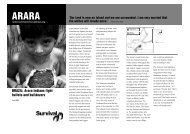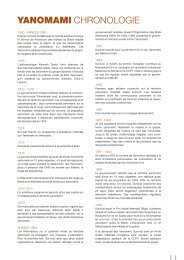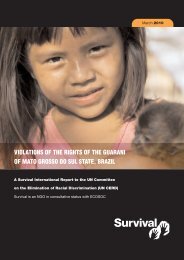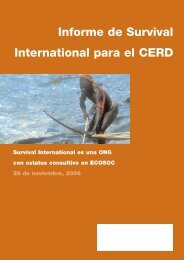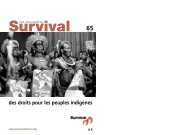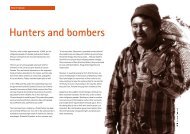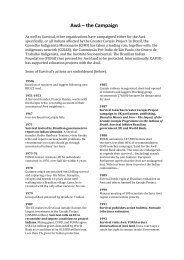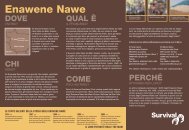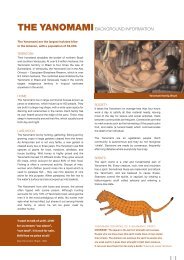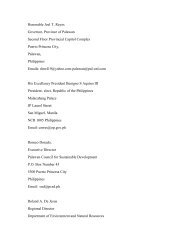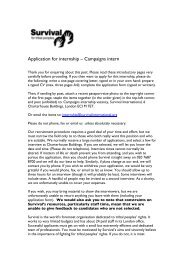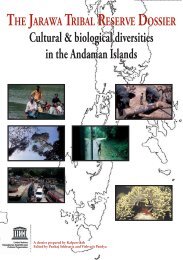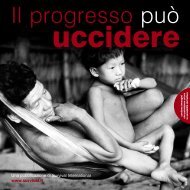Progress can kill - Survival International
Progress can kill - Survival International
Progress can kill - Survival International
Create successful ePaper yourself
Turn your PDF publications into a flip-book with our unique Google optimized e-Paper software.
<strong>Progress</strong><br />
<strong>can</strong><strong>kill</strong><br />
contains images some<br />
may find distressing<br />
a <strong>Survival</strong> <strong>International</strong> publication<br />
www.survival-international.org
‘OUTSIDERS WHO COME HERE ALWAYS CLAIM THEY ARE BRINGING<br />
PROGRESS. BUT ALL THEY BRING ARE EMPTY PROMISES. WHAT WE’RE<br />
REALLY STRUGGLING FOR IS OUR LAND. ABOVE ALL ELSE THIS IS WHAT<br />
WE NEED.’ Arau, Penan man, Sarawak, Malaysia, 2007<br />
‘THESE PLACES [RESETTLEMENT CAMPS] HAVE TURNED OUR PEOPLE<br />
INTO THIEVES AND BEGGARS AND DRUNKARDS. I DO NOT WANT THIS<br />
LIFE. FIRST THEY MAKE US DESTITUTE BY TAKING AWAY OUR LAND,<br />
OUR HUNTING AND OUR WAY OF LIFE. THEN THEY SAY WE ARE<br />
NOTHING BECAUSE WE ARE DESTITUTE.’ Jumanda Gakelebone, Bushman, Botswana, 2007<br />
© <strong>Survival</strong> <strong>International</strong><br />
Published October 2007<br />
ISBN: 978-0-946592-25-8<br />
Editorial team: Dr Jo Woodman and Sophie Grig<br />
Printed by Waterside Press<br />
www.survival-international.org
progress =<br />
forward moving towards a destination;<br />
development towards an improved or advanced condition<br />
<strong>Progress</strong> <strong>can</strong> <strong>kill</strong><br />
‘<strong>Progress</strong>’ is questioned less today than<br />
ever before; it is simply thought to be<br />
good for all. Current notions of progress<br />
date from the colonial era, when the taking<br />
of resources and labour was supposedly<br />
justified by the giving of ‘civilisation’.<br />
So what is progress? For the poor citizens<br />
of the poorer nations, its main pillars are<br />
schooling, which they hope leads to more<br />
money, and healthcare, which they pray<br />
brings longer life. <strong>Progress</strong> <strong>can</strong> <strong>kill</strong> does<br />
not challenge this: some do see their dreams<br />
fulfilled, though others just get poorer.<br />
It is different for tribal peoples, particularly<br />
those with less contact with outsiders.<br />
Forcing ‘progress’ on them never brings<br />
a longer, happier life, but a shorter, bleaker<br />
existence only escaped in death. It has<br />
destroyed many peoples and threatens many<br />
more. There are tribes who are aware of this<br />
and choose to remain isolated. Others have<br />
a closer relationship with outsiders – some of<br />
these receive healthcare intended to mitigate<br />
the devastation they face. But in a deadly<br />
catch-22, the ‘modern’ healthcare available<br />
to tribal peoples – even in the richest nations<br />
– is never enough to counter the effects of<br />
introduced diseases and the devastation<br />
caused by losing their land.<br />
This study does not deny the genius and<br />
achievements of science, or support a<br />
romantic view that harks back to a mythic<br />
golden age. Nor is it a rejection of change<br />
– all societies change always.<br />
The truth is that tribes who live on their own<br />
land – controlling their own adaptation to a<br />
changing world – are poor in monetary terms,<br />
but their quality of life and health is often<br />
visibly better than their compatriots. Indices<br />
show that when tribal peoples are forced<br />
off their land, their health and well-being<br />
plummet, while rates of depression, addiction<br />
and suicide soar. These are provable facts.<br />
Recent attempts to measure ‘happiness’ in<br />
different populations bring no surprises to<br />
those familiar with tribes still in control of their<br />
own lives: the world’s richest billionaires are<br />
no happier than the average Maasai herder.<br />
Projects which remove tribes from their land<br />
and impose ‘progress’ cause untold misery.<br />
This is not surprising: ‘progress’ – the<br />
conviction that ‘we’ know best – shares<br />
with colonialism the effect of taking over<br />
native lands and resources. Tribal peoples<br />
do not survive it. On the other hand, when<br />
on their own land choosing their own<br />
development, they simply thrive.<br />
2 3
progress<br />
the end*<br />
*<br />
90% of many Amerindian tribes died<br />
following contact with Europeans, mostly<br />
from disease. Others were wiped out entirely.<br />
4 5
*‘Measles gradually spread<br />
throughout the whole of the<br />
Great Andaman… Half, if not<br />
two thirds, of the whole of the<br />
Andamanese… died from its<br />
effects… This epidemic was<br />
the most serious disaster<br />
which has befallen the<br />
Andamanese, and owing to<br />
the effects of it our treatment<br />
of them underwent a change;<br />
all attempts to force them to<br />
settle down to an agricultural<br />
life were abandoned…’<br />
M.V. Portman, Officer in charge<br />
of the Andamanese, 1899<br />
‘What we are really doing<br />
is a crime. When I enter into<br />
contact with Indians I know<br />
that I am forcing a community<br />
to take the first step on a road<br />
that will lead them to hunger,<br />
sickness, disintegration, quite<br />
often to slavery, the loss of<br />
their traditions, and in the<br />
end death in complete misery<br />
that will come all too soon.’<br />
Antonio Cotrim, FUNAI (Brazil’s<br />
Indian affairs department), 1972<br />
contact<br />
The British brought ‘progress’ to the Great Andamanese by putting<br />
them in a ‘home’ to give them a better way of life. Of 150 babies<br />
born, all died before their third birthday. Overall, 99% of the tribe<br />
died, leaving just 53 people today. They survive on handouts,<br />
many have tuberculosis, and most men are alcoholics.<br />
Their neighbours on the Andaman Islands, the Jarawa, have<br />
been on their land for around 60,000 years – five times longer<br />
than the ancestors of the British have been in Britain. The Jarawa<br />
have remained isolated and self-sufficient, and are still very healthy.<br />
Their survival is now threatened by a road which cuts through<br />
their land, bringing poachers and new diseases such as measles.<br />
The Indian supreme court has ordered the road to be closed, but<br />
the local administration has refused to comply, and it remains open.<br />
population<br />
Great Andamanese population<br />
7000<br />
•<br />
6000<br />
5000<br />
4000<br />
3000<br />
2000<br />
1000<br />
0<br />
1800<br />
•<br />
••<br />
• ••••<br />
• year<br />
1850 1900 1950 2000 2050<br />
A Jarawa child stands<br />
by the Andaman Trunk<br />
Road which runs through<br />
the Jarawa’s land.<br />
6 7
*<br />
life expectancy<br />
<strong>Progress</strong> has brought displacement, impoverishment and the<br />
destruction of communities to the Aboriginal peoples of Australia.<br />
Compared to other Australians, Aborigines are:<br />
On average, Aborigines<br />
live 10 years longer<br />
when on their own<br />
land, than those in<br />
resettled communities.<br />
‘The health of Aboriginal<br />
and Torres Strait Islander<br />
Australians is disastrously<br />
poor... the fundamental cause<br />
is disempowerment, due<br />
to various factors including<br />
continued dispossession from<br />
the land, cultural dislocation,<br />
poverty, poor education and<br />
unemployment.’<br />
Royal Australasian College<br />
of Physicians (RACP), 1997<br />
6 times more likely to die as an infant;<br />
6 times more likely to die from a stroke;<br />
8 times more likely to die from lung or heart disease;<br />
22 times more likely to die from diabetes.<br />
Their life expectancy at birth is 17-20 years<br />
less than other Australians.<br />
Life expectancy (years)<br />
‘The first step in the<br />
90<br />
journey of healing is to<br />
80<br />
reconnect with the land.<br />
70<br />
It symbolises so much<br />
60<br />
to us: it’s our family, our<br />
parents, our grandparents.<br />
It’s the umbilical cord,<br />
the bond between mother<br />
and children.’<br />
Doris Pilkington Garimara,<br />
Aboriginal author of Follow<br />
the Rabbit Proof Fence, 2003<br />
50<br />
40<br />
30<br />
20<br />
10<br />
0<br />
Canada New Zealand Australia<br />
women: all<br />
women: Aboriginal<br />
men: all<br />
men: Aboriginal<br />
8 9
progress<br />
HIV/AIDS*<br />
*<br />
In 2002, over 40% of deaths of<br />
Gana and Gwi Bushmen in one<br />
resettlement camp were due to AIDS.<br />
10 11
*‘The infection of the Parakanã<br />
with venereal diseases was<br />
not an isolated case: it was<br />
symptomatic of brutal<br />
attitudes to newly contacted<br />
Indians along the new roads.’<br />
John Hemming, 2003,<br />
Die If You Must<br />
‘I want to go and be buried<br />
in my home in Molapo [in<br />
the Central Kalahari Game<br />
Reserve, Botswana]. I am<br />
sick now, I am about to<br />
die… We were the first<br />
people from Molapo to be<br />
evicted. Here in New Xade<br />
[government relocation camp]<br />
there are different kinds of<br />
diseases that we do not<br />
recognise… When you<br />
get sick, you die.’<br />
Bushman woman who died<br />
of AIDS in 2006, aged 29.<br />
Before they were moved to<br />
resettlement camps, there<br />
were no reported Bushman<br />
deaths due to this disease.<br />
HIV/AIDS<br />
‘<strong>Progress</strong>’, from road building to relocation, brings prostitution,<br />
the abuse of tribal women and children, and sexual diseases.<br />
In 1971, Brazilian government efforts to establish ‘friendly contact’<br />
with isolated Indians brought gonorrhoea to the Parakanã. Thirty-five<br />
Indian women were infected by government workers; some of their<br />
children were born blind.<br />
Indonesian occupation is disastrous for indigenous Papuans. Their<br />
rate of HIV/AIDS infection is 15 times the national average and<br />
rising rapidly. However, health education and testing is focussed on<br />
the Indonesian population, not the indigenous tribes. Soldiers take<br />
prostitutes and alcohol to tribal leaders to bribe them to give up their<br />
most precious wood, which is sold for incense. Many Papuans even<br />
believe that the Indonesian army is deliberately introducing HIV as a<br />
tool for genocide. Some tribes now face annihilation from the disease.<br />
Confirmed cases of HIV/AIDS in Papua<br />
2000<br />
1800<br />
•<br />
1600<br />
1400<br />
1200<br />
1000<br />
•<br />
800<br />
600<br />
•<br />
400<br />
200<br />
0 • • •<br />
• • •<br />
1988 1992 1996 2000 2004<br />
A nurse helps move<br />
an indigenous patient<br />
dying of AIDS, Papua<br />
New Guinea. HIV/AIDS<br />
is predicted to reach<br />
epidemic proportions<br />
in both PNG and Papua.<br />
12 13
progress<br />
starvation*<br />
* Guarani children are dying of starvation.<br />
In one of Brazil’s wealthiest regions,<br />
14 15
*<br />
starvation<br />
In 2005, most Guarani Mbyá children in Iguazu, Argentina, were<br />
malnourished. In the following year, 20 children died from starvation<br />
in just three months. These Indians are losing 10% of their land<br />
annually, and just <strong>can</strong>not grow enough food.<br />
Over the border lies one of Brazil’s wealthiest regions where<br />
over 11,000 Guarani Indians live, squeezed into an area which<br />
<strong>can</strong> barely support 300. Their children are dying of starvation.<br />
Almost no other tribe has suffered such an extreme loss of<br />
land and survived.<br />
The forests which gave the Guarani their food are being rapidly<br />
cleared for cattle ranches, and soya and sugar plantations. The<br />
government’s response is to give out oil, rice and flour, but the<br />
Indians <strong>can</strong> no longer even find the wood to cook these meagre<br />
handouts. Tribes who choose their own way of life on their own<br />
land may occasionally go hungry, but malnutrition is extremely rare.<br />
The Guarani need their land back or they will simply not survive.<br />
Aché women starving<br />
after being forced out<br />
of the forest, Paraguay.<br />
‘We were a free people<br />
who lived surrounded<br />
by abundance. Today<br />
we live dependent on<br />
the government’s aid.<br />
It is like having a gun<br />
cocked against our heads.’<br />
Guarani-Kaiowá<br />
leaders, Brazil, 2005<br />
‘I always remember one old man said, “The whites<br />
– they’re going to finish you off. They’re going to<br />
finish off our houses, finish off our fish, even our<br />
crops. And once all our forest is gone, we as a people<br />
will be finished. It’s all going to change and our land<br />
will become very small.” And you know, that man,<br />
all those years ago, calculated absolutely right.’<br />
Paulito, an elderly Guarani shaman, Brazil.<br />
16 17
progress<br />
obesity*<br />
*<br />
In Australia, 64% of urban<br />
Aborigines suffer from obesity.<br />
18 19
*‘Without urgent action<br />
there certainly is a real<br />
risk of a major wipe-out<br />
[due to diabetes] of<br />
indigenous communities,<br />
if not total extinction,<br />
within this century.’<br />
Professor Zimmet, <strong>International</strong><br />
Diabetes Institute, 2006<br />
‘The human costs of<br />
unrestrained development<br />
on our traditional territory,<br />
whether in the form of<br />
massive hydroelectric<br />
development or irresponsible<br />
forestry operations, are no<br />
surprise for us. Diabetes has<br />
followed the destruction of<br />
our traditional way of life<br />
and the imposition of a<br />
welfare economy. Now<br />
we see that one in seven<br />
pregnant Cree women is<br />
sick with this disease, and<br />
our children are being born<br />
high risk or actually sick.’<br />
Matthew Coon-Come, Cree, 2002<br />
obesity & diabetes<br />
Tribal peoples without land are forced into a sedentary life and<br />
many become dependent on processed foods. This change in<br />
lifestyle and diet – from high-protein to high-fat food – is often<br />
disastrous, leading to obesity, high blood pressure and diabetes.<br />
In the Pima reservation (Arizona), more than half of Indians over<br />
the age of 35 have diabetes; while those living in the mountains<br />
suffer far less from this condition. The <strong>International</strong> Diabetes<br />
Federation predicts that excess weight and diabetes will lead to<br />
‘earlier deaths and disabilities’. If untreated or detected late – as<br />
is common with tribal peoples – diabetes <strong>can</strong> lead to blindness,<br />
kidney failure, strokes, heart disease and amputations. The<br />
impact on future generations will be catastrophic.<br />
Protein and fat in traditional<br />
and shop-bought foods (grams per 100g)<br />
50<br />
45<br />
40<br />
35<br />
30<br />
25<br />
20<br />
15<br />
10<br />
5<br />
0<br />
Caribou Beaver Moose Luncheon<br />
meat<br />
Steak<br />
Frankfurter<br />
fat<br />
protein<br />
Indians and Inuit are<br />
two to three times<br />
more likely to suffer<br />
from diabetes than<br />
other Canadians.<br />
20 21
progress<br />
suicide*<br />
*<br />
Between 1985 and 2000, over 300<br />
Guarani-Kaiowá committed suicide.<br />
The youngest was nine years old.<br />
22 23
*‘Young<br />
people are nostalgic<br />
for the beautiful forests...<br />
A young person told me he<br />
didn’t want to live anymore<br />
because there was no reason<br />
to carry on living – there is<br />
no hunting, no fishing, and<br />
the water is polluted.’<br />
Amilton Lopes, Guarani,<br />
Brazil, 1996<br />
suicide<br />
Tribal people across the world suffer from the trauma of forced<br />
relocation and settlement. They find themselves in an environment<br />
they are not used to, where there is nothing useful to do, and<br />
where they are treated with racist disdain by their new neighbours.<br />
Their children may be taken to boarding schools which separate<br />
them from their communities and often forbid or ridicule their<br />
language and traditions.<br />
Alienated and without hope, many take to drugs and alcohol.<br />
Domestic violence and sexual abuse soar. Many resort to suicide.<br />
In Canada, Indian groups who have lost their connection to their<br />
land have suicide rates up to 10 times the national average;<br />
those with strong links often see no suicides at all.<br />
‘The Guarani are committing<br />
suicide because we have no<br />
land. We don’t have space<br />
any more. In the old days,<br />
we were free, now we are<br />
no longer free. So our young<br />
people look around them and<br />
think there is nothing left and<br />
wonder how they <strong>can</strong> live.<br />
They sit down and think,<br />
they forget, they lose<br />
themselves and then<br />
commit suicide.’<br />
Rosalino Ortiz, Guarani<br />
Ñandeva, Brazil, 1996<br />
400<br />
350<br />
300<br />
250<br />
200<br />
150<br />
100<br />
Suicide rates for indigenous and national<br />
populations for men aged 15-24 years (per 100,000)<br />
50<br />
0<br />
Canada<br />
Denmark<br />
(incl. Greenland)<br />
national suicide rate<br />
indigenous suicide rate<br />
USA<br />
In 1995, 56 Guarani<br />
Indians took their own<br />
lives – more than one<br />
suicide per week. The<br />
Guarani have asked<br />
<strong>Survival</strong> to use images<br />
such as this one to<br />
publicise their plight.<br />
24 25
progress<br />
addiction*<br />
One third of Innu children sniff petrol.<br />
*Many start as young as five years old.<br />
26 27
*‘We were ashamed of<br />
ourselves… [We had] lost<br />
our mastery. Our sons were<br />
ashamed of us. We had no<br />
self-respect and nothing to<br />
give our sons except violence<br />
and alcoholism. Our children<br />
are stuck somewhere between<br />
a past they don’t understand<br />
and a future that won’t<br />
accept them and offers<br />
them nothing.’<br />
Boniface Alimankinni,<br />
Tiwi Islands, Australia, 2006<br />
addiction<br />
Dispossessed and alienated tribal peoples often take to drugs,<br />
usually the cheapest and most easily available such as alcohol<br />
and petrol. The health of individuals and families collapses. Babies<br />
are born with foetal alcohol syndrome, children get little care from<br />
addict parents, teenagers follow suit, and once-respected elders<br />
are alienated from younger generations. Cycles are fixed which<br />
<strong>can</strong>not be broken by merely treating individuals or symptoms.<br />
The entire society falls apart.<br />
Among Innu youth, sniffing petrol is an acute problem. In the<br />
long term this addiction <strong>can</strong> cause convulsions and permanent<br />
damage to the kidneys, eyes, liver, bone marrow and heart.<br />
In 2000, 11-year-old Charles Rich died by accidentally setting<br />
himself on fire when sniffing petrol. A child who witnessed this<br />
horrific death said:<br />
‘The [Bushman resettlement]<br />
camps looked like abandoned<br />
mine camps with little or no<br />
economic activity. At both<br />
camps, alcohol abuse was<br />
visible from the many people<br />
‘My name is Phillip. I’m a gas [petrol] sniffer. I sniff gas<br />
with my friends. In wintertime, we steal skidoos and we<br />
steal gas... I don’t go home because I sniff gas. And I<br />
sniff gas because both my parents are drinking and I’m<br />
mad at that... At one point Charles ran towards me when<br />
(old and young) seen drunk…<br />
The settlements do not<br />
provide any visitor with<br />
a sense of hope and future<br />
he was in flames, but because I was sniffing gas and the<br />
fumes were very strong on me, I ran away. I was afraid<br />
I would be caught on fire too.’<br />
for the residents.’<br />
Afri<strong>can</strong> Commission on Human<br />
and Peoples’ Rights, 2006<br />
Alienated Innu<br />
children turn to<br />
sniffing petrol<br />
28<br />
from plastic bags.<br />
29
‘We want to participate<br />
actively and have close<br />
control over healthcare<br />
in our indigenous areas,<br />
because we know our<br />
reality and the needs<br />
of the communities<br />
we represent... We do<br />
not accept that a nonindigenous<br />
organisation...<br />
with no experience of<br />
working with indigenous<br />
peoples’ health, <strong>can</strong> take<br />
over indigenous healthcare.’<br />
Brazilian Indian leaders, 2006<br />
‘I feel a lot better about<br />
myself out here in the<br />
country. In the reserve<br />
all I do is drink… I like it<br />
here. It’s peaceful. There<br />
are no drunks or drugs.’<br />
Jonathan Walsh,<br />
Innu, Canada, 2006<br />
health & freedom<br />
The Yanomami story<br />
The Yanomami Indians of Amazonia suffered<br />
catastrophic decline in the 1980s and 1990s<br />
when miners invaded their territory, bringing<br />
disease and violence. Twenty percent died in<br />
seven years. Brazilian government assistance<br />
achieved little: what the Yanomami really<br />
needed to survive and recover was their<br />
land and their own healthcare.<br />
It happened. In 1992, after a 23-year<br />
campaign led by <strong>Survival</strong> and the Pro-<br />
Yanomami Commission (CCPY), the<br />
Yanomami Park was created. This gave<br />
these Amazonian Indians control over<br />
almost 10 million hectares of rainforest.<br />
During this time, independent medical staff<br />
were recruited to work alongside traditional<br />
Yanomami healers. This new health initiative,<br />
Urihi – which was supported by <strong>Survival</strong> –<br />
reduced the number of deaths by half. In<br />
2004, the Brazilian government took it<br />
over by decree. Spending was doubled,<br />
but disease rocketed. Some communities<br />
saw fatal cerebral malaria increase four-fold.<br />
The model for proper healthcare amongst<br />
tribal peoples is tried, tested, and cheaper<br />
than alternatives: outsiders must treat the<br />
people and their own knowledge with respect;<br />
tribespeople must be trained themselves to<br />
give all but the most specialised treatment;<br />
and outside health workers must build a<br />
mutually supportive relationship with the<br />
communities they work in.<br />
*<br />
Tribal people living in freedom on their<br />
own land, making decisions about their<br />
own lives, are far healthier than those who<br />
have been uprooted and had ‘progress’<br />
forced upon them. If they suffer from<br />
diseases introduced from outside, they<br />
need appropriate healthcare delivered<br />
with respect and sensitivity.<br />
Tribal people are damaged by racism and<br />
a clash of cultures when links to their land<br />
and identity have been broken. Helping them<br />
to rebuild those links is the most effective and<br />
efficient cure of all.<br />
It is simple common sense, but the major<br />
obstacle facing tribal peoples is the archaic<br />
notion – held by governments and many<br />
aid organisations – that the problem facing<br />
tribal peoples is their lack of progress. It isn’t.<br />
30 31
‘It is not that the Yanomami do not want progress, or<br />
other things that white people have. They want to be<br />
able to choose and not have change thrust upon them,<br />
whether they want it or not. I am not saying I am against<br />
progress. I think it is very good when whites come to work<br />
amongst the Yanomami to teach reading and writing and<br />
to plant and use medicinal plants. This for us is progress.<br />
What we do not want are the mining companies which<br />
destroy the forest and the miners, who bring so many<br />
diseases. These whites must respect our Yanomami<br />
land. The miners bring guns, alcohol and prostitution<br />
and destroy all nature wherever they go. For us this is<br />
not progress. We want progress without destruction.’<br />
Davi Kopenawa, Yanomami shaman, Brazil, 2003<br />
* act now<br />
we need your help<br />
*<br />
Pledge your support and<br />
count on me!<br />
get active for threatened<br />
tribal peoples. Visit our<br />
website to find out how:<br />
www.survival-international.org/<br />
progress<strong>can</strong><strong>kill</strong><br />
*<br />
Help make sure the world<br />
raise awareness<br />
hears the voice of vulnerable<br />
tribes, and takes action.<br />
*<br />
donate<br />
<strong>Survival</strong> accepts no<br />
government funding.<br />
Without your support,<br />
we <strong>can</strong> do nothing. With<br />
it, we <strong>can</strong> help give tribal<br />
peoples a future.<br />
*<br />
Join our online blog at,<br />
have your say<br />
www.survivalinternational.org/blog<br />
To read the full report, <strong>Progress</strong> <strong>can</strong> <strong>kill</strong>: how imposed<br />
development destroys the health of tribal peoples visit:<br />
www.survival-international.org/progress<strong>can</strong><strong>kill</strong><br />
To get involved, and to help stop injustices<br />
against tribal peoples, please contact us.<br />
We help tribal peoples defend<br />
their lives, protect their lands<br />
and determine their own futures.<br />
<strong>Survival</strong> <strong>International</strong> (head office)<br />
6 Charterhouse Buildings,<br />
London EC1M 7ET, UK<br />
T: +44 (0)20 7687 8700<br />
info@survival-international.org<br />
www.survival-international.org<br />
© <strong>Survival</strong> <strong>International</strong> 2007<br />
Photo credits: front cover: Yanomami father and son, Brazil © Victor Englebert 1980/<strong>Survival</strong>; inside cover:<br />
Yanomami mother and child, Brazil © Antonio Ribeiro; p7 © Salomé/<strong>Survival</strong>; p9 © Mikkel Ostergaard/Panos; p13<br />
© David Gray/Reuters; p16: Guarani mother and child, Brazil © João Ripper/<strong>Survival</strong>; p17 © Don McCullen/<strong>Survival</strong>;<br />
p21 © Dominick Tyler/<strong>Survival</strong>; p25 © João Ripper/<strong>Survival</strong>; p29 © Dominick Tyler/<strong>Survival</strong>; p30: Gana Bushman boy,<br />
Botswana © Stephen Corry/<strong>Survival</strong>; p31: (far left) Yanomami woman, Brazil © Jerry Callow/<strong>Survival</strong>; p31: (centre)<br />
Davi Kopenawa, Yanomami, Brazil © Fiona Watson/<strong>Survival</strong>.<br />
32
‘WHAT KIND OF DEVELOPMENT IS IT WHEN THE PEOPLE<br />
LEAD SHORTER LIVES THAN BEFORE? THEY CATCH<br />
HIV/AIDS. OUR CHILDREN ARE BEATEN IN SCHOOL<br />
AND WON’T GO. SOME BECOME PROSTITUTES. THEY<br />
ARE NOT ALLOWED TO HUNT. THEY FIGHT BECAUSE<br />
THEY ARE BORED AND GET DRUNK. THEY ARE STARTING<br />
TO COMMIT SUICIDE. WE NEVER SAW THAT BEFORE.<br />
IS THIS “DEVELOPMENT”?’ Roy Sesana, Gana Bushman, Botswana, 2005<br />
£3 €4.5<br />
ISBN 978-0-946592-25-8<br />
9 780946 592258



